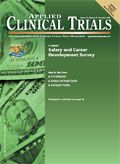The GXP Training Guidelines: Raising Standards Through Competence-Based Training
Applied Clinical Trials
There is currently no set of standards for how individuals acquire the ability to perform satisfactorily and demonstrate the required levels of competence.
Many industries have training standards such as the automotive sector, the renewable energy industry, and specialist areas such as forklift truck driving. In the field of clinical research, guidelines and regulations such as the ICH Harmonized Tripartite Guideline—Guideline for Good Clinical Practice E6(R1) make very general references to training. "Each individual involved in conducting a trial should be qualified by education, training, and experience to perform his or her respective task(s)" (ICH GCP principle 2.8). However there is currently no set of standards for how individuals acquire the ability to perform satisfactorily and demonstrate the required levels of competence.

The guidelines were designed to share best training practices for anyone involved in the training and development of clinical research professionals. (Source: Getty Images)
In response, the International Academy of Clinical Research (IAoCR) set up a taskforce to produce GXP training guidelines. The aim of these guidelines is to share best training practices for anyone involved in the training and development of clinical research professionals. The guidelines are designed for use in any organization no matter what size, both in the non-commercial and commercial sectors.
The guidelines cover the key steps in developing competent individuals, starting with creating a competency framework, through to the assessment of learning and its documentation. The overriding theme of the guidelines is how to use various learning interventions to achieve learner competence. Having competent individuals is vital in clinical research for protecting the rights and well-being of patients and securing verifiable and accurate data. A further benefit is that new treatments for patients can be developed without unnecessary delays or costs due to errors and rework because of incompetence.
By using the guidelines, organizations can demonstrate a real investment in their people, which leads to other advantages such as increased staff retention and a sound basis for promotions and succession planning.
The taskforce that created the guidelines was made up of five clinical research professionals from various backgrounds and organizations, and represented Europe, the Americas, and the Indian sub-continent. After some additional input from the IAoCR, the first draft of the guidelines was circulated for consultation to approximately 40 organizations worldwide involved in clinical research and included universities and not-for-profit professional bodies. Following refinement from this initial consultation, a second round of opinion was sought from over 200 individuals working in all sectors of the international clinical research community. The guidelines were finalized and released in mid-November.
The content of the guidelines covers how to:
- Define competencies for job roles
- Conduct a learning needs analysis
- Select trainers
- Design and deliver learning interventions
- Assess the effectiveness of the interventions
- Gather learners' feedback
- Manage the documentation
In addition, there is a set of appendices containing examples, templates, and a reading list for those who want a more in-depth coverage of any of the topics.
Initial reaction has been very positive. The hope is to see universal take-up of the guidelines in developing competent individuals for the benefit of clinical research worldwide.
—Martin Robinson, PhD, Principal Director, International Academy of Clinical Research Ltd

Improving Relationships and Diversifying the Site Selection Process
April 17th 2025In this episode of the Applied Clinical Trials Podcast, Liz Beatty, co-founder and chief strategy officer, Inato, discusses a number of topics around site engagement including community-based sites, the role of technology in improving site/sponsor relationships, how increased operational costs are impacting the industry, and more.
Behind the Buzz: Why Clinical Research Leaders Flock to SCOPE Summit
February 7th 2025In this episode, we meet with Micah Lieberman, Executive Conference Director for SCOPE Summit (Summit for Clinical Ops Executives) at Cambridge Innovation Institute. We will dive deep into the critical role of collaboration within the clinical research ecosystem. How do we bring together diverse stakeholders—sponsors, CROs, clinical trial tech innovators, suppliers, patients, sites, advocacy organizations, investors, and non-profits—to share best practices in trial design, program planning, innovation, and clinical operations? We’ll explore why it’s vital for thought leaders to step beyond their own organizations and learn from others, exchanging ideas that drive advancements in clinical research. Additionally, we’ll discuss the pivotal role of scientific conferences like SCOPE Summit in fostering these essential connections and collaborations, helping shape the future of clinical trials. Join us as we uncover how collective wisdom and cross-industry partnerships are transforming the landscape of clinical research.